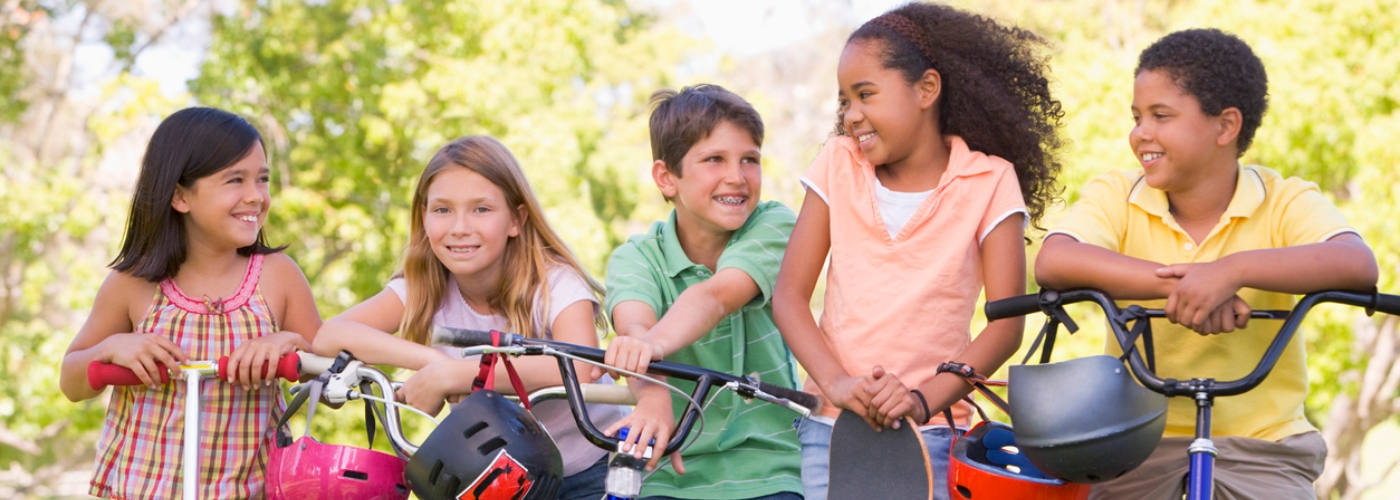A step-by-step guide to bike and skateboard safety

Promoting safety while children indulge in the fun is essential for parents. When it comes to bikes and skateboards, it's important to teach our children correct riding techniques, ensuring they use appropriate safety gear like helmets and knee pads and teaching them road safety rules.
Preventing common injuries while biking or skateboarding
Bicycling is among the top 5 leading causes of injury in children between five and 14 years old. The best way to protect against common injuries while biking or skateboarding is through proactive measures.
"Start with the basics — always ensure your child wears a properly fitted helmet, wrist guards and elbow and knee pads," says explains Lisa Eckenrode, trauma injury prevention and outreach coordinator at Paoli Hospital.
Protective gear can significantly reduce the risk of fractures, abrasions and head injuries.
Be sure to encourage safe riding practices, such as avoiding uneven surfaces crowded areas, as well as riding in the correct direction and not attempting tricks beyond their skill level. It's also crucial to supervise young riders and skateboarders to make sure they're playing safely.
Finding the right helmet size
Ensuring your child's helmet fits correctly is a critical aspect of both bike and skateboard safety.
When positioned correctly, the helmet should sit low on the forehead, right above the eyebrows, and should not tilt either forward or backward. The fit should be snug yet comfortable, without the helmet rocking from side to side. Once the helmet is on, secure the chin strap, adjusting it so that there's just enough space to slide one or two fingers between the strap and the chin.
Remember, a properly fitting helmet significantly reduces the risk of serious injury. Don't underestimate the importance of a well-fitted helmet — it's an easy adjustment that could have a big impact on safety.
*Helmets are now available for $11 through Main Line Health Community Health and Equity.
When to replace bike and skateboard helmets: Signs of wear and tear
Regular inspection of your child's bike or skateboard helmet is critical in maintaining its effectiveness in protecting them. Over time, natural wear and tear can reduce a helmet's protective abilities.
Start by visually inspecting the helmet for any noticeable signs of damage like cracks, dents or scrapes on the outer shell or inside padding. If the helmet has suffered a significant impact, like a serious fall or collision, it should be replaced immediately, even if there are no visible signs of damage. Even if the helmet seems in good condition, experts recommend replacing it every 3 to 5 years due to material break down over time.
Also, check the helmet straps for any fraying or loosening, as these ensure a secure fit, and the buckle for any cracks, as these parts impact a secure fit. If your child has outgrown their helmet, replace it.
Consider a multi-use helmet
If your child loves to ride their bike and zoom around on their skateboard, it might be worth considering a multi-use helmet. These helmets are designed to meet safety standards for a range of activities, giving your child the head protection they need.
It's a practical solution, offering the versatility to keep up with their varied interests. But remember, even with multi-use helmets, the fit is still crucial. So ensure it comfortably hugs their head, and is age and size appropriate.
Grownups: Don't forget your helmet
Let's not forget that safety is for everyone, not just our children. As parents and loved ones, it's important to model good behavior. This means that when we strap on our helmets before hopping onto a bike or skateboard, we're demonstrating to children that safety is a priority, no matter how old we are. Plus, it subtly communicates to them that helmets aren't something we outgrow but a non-negotiable part of these fun-filled activities.
"Don't just tell them about safety, show them. Lead the way, because after all, actions often speak louder than words," says Lisa. "This simple act can encourage everyone, especially our children, to understand the importance of bike safety and skateboard safety, creating a lasting impression that will stick with them throughout their riding and gliding adventures."
What to do for a fall or injury
Despite our best safety efforts, spills and tumbles can sometimes happen. If your child does have a fall, it's important to remain composed. First, examine for any obvious injuries. Secondly, be aware of any signs of a concussion, which may include disorientation, a persistent headache, bouts of dizziness or feeling sick to their stomach. Should your child exhibit any of these symptoms, it's essential to promptly seek professional medical assistance.
If something does happen such as a spill, crash, or fall, remember what's most important is how we respond to them. Understanding the correct steps to take in these instances can make a significant difference in your child's wellbeing. As the saying goes, it's better to be safe than sorry. So, while we aim for a fun-filled, accident-free year full of bike rides and skateboarding adventures, it's vital to be prepared for any bumps that might come along the way.
Next steps:
Learn more about pediatric care at Main Line Health
Tips for helping your children use social media mindfully
Protecting your young athletes brain
 Content you want, delivered to your inbox
Content you want, delivered to your inbox
Want to get the latest health and wellness articles delivered right to your inbox?
Subscribe to the Well Ahead Newsletter.
